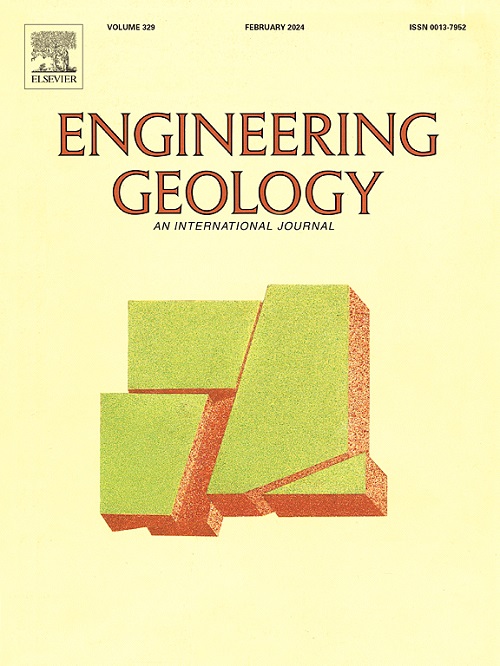膨润土中随温度变化的结合水退化定量研究
IF 8.4
1区 工程技术
Q1 ENGINEERING, GEOLOGICAL
引用次数: 0
摘要
饱和粘土中温度的升高会改变粘土与水的物理化学相互作用,并可能导致结合水转化为自由水。这些变化会极大地影响粘土的物理、化学和工程特性,而这些特性对于岩土工程和地质工程以及最大限度地降低膨胀性粘土地区的风险至关重要。然而,文献中对这一现象的量化仍然具有挑战性。本研究提出了一种稳健的实验方法,用于量化粘土中结合水的热诱导转化,为了解其热力学行为机理提供了宝贵的见解。研究提出了一种新颖的实验方法,用于量化粘土体系在 20 至 50 °C 温度条件下的退化结合水含量。研究采用虹吸原理来检测粘土体系在高温下的体积变化,重点是测量结合水向自由水的转化。这种方法考虑了土壤成分和密闭玻璃缸的热膨胀以及潜在的蒸发损失。为验证该装置的准确性,使用结合水含量极低的标准渥太华砂进行了校准测试。在测量系统误差后,对主要结果进行了校准。结果显示,在 30 °C、40 °C 和 50 °C,初始结合水分别有 3%、9% 和 15% 转化为自由水。本文章由计算机程序翻译,如有差异,请以英文原文为准。
Quantitative investigation of temperature-dependent bound water degeneration in bentonite clays
Temperature increases in saturated clay alter the physicochemical clay-water interactions and may lead to the conversion of bound water into free water. These changes significantly influence the physical, chemical, and engineering properties of clays, which are critical for geotechnical and geological engineering and minimizing risks in areas with expansive clay soils. However, quantifying this phenomenon remains challenging in the literature. This study presents a robust experimental approach for quantifying the thermal-induced conversion of bound water in clays, providing valuable insights into the mechanisms governing their thermo-mechanical behavior. A novel experimental method is proposed to quantify the degenerated bound water content in a clay system subjected to temperatures ranging from 20 to 50 °C. The research employs the siphon principle to examine volume changes in a clay system at elevated temperatures, focusing on measuring the conversion of bound water to free water. This method accounts for thermal expansion of both the soil constituents and the confining glass cylinder, as well as potential evaporation losses. To validate the setup's accuracy, a calibration test using standard Ottawa sand with negligible bound water was performed. After measuring system error, the primary outcome was calibrated. Results showed that at 30 °C, 40 °C, and 50 °C, 3 %, 9 %, and 15 % of the initial bound water, respectively, converted to free water.
求助全文
通过发布文献求助,成功后即可免费获取论文全文。
去求助
来源期刊

Engineering Geology
地学-地球科学综合
CiteScore
13.70
自引率
12.20%
发文量
327
审稿时长
5.6 months
期刊介绍:
Engineering Geology, an international interdisciplinary journal, serves as a bridge between earth sciences and engineering, focusing on geological and geotechnical engineering. It welcomes studies with relevance to engineering, environmental concerns, and safety, catering to engineering geologists with backgrounds in geology or civil/mining engineering. Topics include applied geomorphology, structural geology, geophysics, geochemistry, environmental geology, hydrogeology, land use planning, natural hazards, remote sensing, soil and rock mechanics, and applied geotechnical engineering. The journal provides a platform for research at the intersection of geology and engineering disciplines.
 求助内容:
求助内容: 应助结果提醒方式:
应助结果提醒方式:


